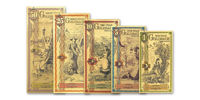Meet the Goldback – Physical Gold You Can Actually Spend
Posted on April 28, 2022
By Paul Vanguard, for BullionMax.com
We've heard more talk of a
gold standard in the last few years than the last decade or two. Once again, and to nobody's surprise, the Federal Reserve went back to money manipulation to try and save the U.S. economy. But at what cost? After trillions of newly-printed dollars flooded the globe, we’re seeing some truly historic effects. Today’s dollars buy 8.5% less than last year’s dollars, and have “officially” lost a
staggering 10.3% of their purchasing power in the last 27 months!
It's no surprise that everyday Americans are
desperate for a stable store of value. How are we supposed to plan for the future when we aren’t sure from one month to the next how much groceries will cost?
Look at any definition of money and you’ll see that it serves as a
unit of account. Without a stable unit of account, planning for the future becomes an exercise in crystal ball-gazing. That’s a major reason we’re seeing a huge demand from everyday folks to
buy gold bullion to preserve their purchasing power. That’s one way to insulate your savings from inflation.
The problem is, we can’t transact directly with
gold coins. Even the smaller fractionals, like
1/10 oz gold coins, aren’t small change. And we know both from practical experience and from history, smaller denominations of money are more heavily circulated than larger denominations. Economists call this the “
small coin problem” and it’s the reason our Founding Fathers paid their bills with
Spanish coins chopped into small pieces.
Furthermore, despite its many shortcomings, the dollar is still the “unit of account” both in the U.S. and for the majority of international transactions. If you want to buy something with your
Canadian gold maple leaf, you have to:
- Sell your gold coin for dollars
- Pay taxes on the sale
- Spend those dollars
- Pay taxes on that transaction, too
- Find something to do with those leftover IOUs from the federal government
So how can we use gold as more than just a store of value? Today, it’s easier than ever to
buy gold, but how do we
pay with gold?
Fortunately, very smart people have solved this problem in a surprising way…
The Goldback: real intrinsically-valuable gold money
Goldbacks are an innovation that combines convenience and bullion-backed intrinsic value. Goldbacks aim to be the best of both worlds.
So let’s discuss how Goldbacks solve those problems we described above:
Inflation, stable store of value
Solved. Since Goldbacks contain physical gold, they have intrinsic value. You couldn’t print an infinite number of them because the world would run out of gold. The Goldback’s value is as stable as
gold’s price.
Small coin problem
Solved. The smallest denomination, which contains 1/1000
th troy oz of gold, has a spot value of about $2 and an exchange rate of $3.86 at the moment.
Paying with gold
Somewhat solved. State-specific Goldbacks are legal money in Utah, Nevada and New Hampshire. Based on legwork done by the team behind the Goldback, somewhere between 1/4 and 1/2 of small businesses who accept cash also accept Goldbacks. So there’s certainly not
universal acceptance, far from it! (Imagine the look on the Home Depot cashier’s face if you tried to pay this way…)
Goldbacks are trying to do the same thing the
Krugerrand tried – to turn gold into money,
not by putting an absurdly low face value on it. But instead by creating a gold product with
real, intrinsic value that’s suitable for circulation.
A closer look at the Goldback
A sealed Goldback is as-advertised: it has a face value of a 1000th of an ounce of gold. Different denominations are available, with the 1 Goldback version being the most popular. It's a rugged piece of polyester with a pretty neat design, covered with fine layer gold particles, then laminated with a tough, clear film. That's the basic description: the actual process of creating them is interesting! See the video below.
Goldbacks are layered with multiple anti-counterfeiting technologies. (Almost to the
atomic level.) Each has a unique serial number that can be verified and authenticated with the manufacturer. So they’re not just
sound money, they’re also
secure money.
Right now, Goldbacks occupy a space between a collector's item and something you take to the store and probably spend, if you really insist.
The inventors of Goldbacks have really done something special. In fact, in their native Utah, they've even ensured that 1000 Goldbacks can be exchanged for a 1 oz American gold eagle or gold buffalo through a partnership.
But with Goldbacks taking off like they have in just a couple years, I doubt we’ll see too many folks swapping them for 1 oz coins.
Yes, they’re really made out of gold… Here’s an in-depth video about the production process:
Here’s a shorter production video from the manufacturer:
…and they’re pretty darned tough. This guy did a torture test…
Paul Vanguard is a lifelong precious metals enthusiast and a proud member of the BullionMax team.
